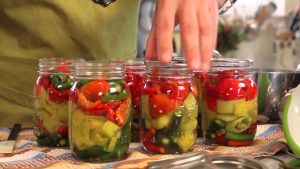A multi‐country outbreak of Listeria monocytogenes ST6 linked to blanched frozen vegetables (bfV) took place in the EU (2015–2018). Evidence of food‐borne outbreaks shows that L. monocytogenes is the most relevant pathogen associated with bfV.
 The probability of illness per serving of uncooked bfV, for the elderly (65–74 years old) population, is up to 3,600 times greater than cooked bfV and very likely lower than any of the evaluated ready‐to‐eat food categories. The main factors affecting contamination and growth of L. monocytogenes in bfV during processing are the hygiene of the raw materials and process water; the hygienic conditions of the food processing environment (FPE); and the time/Temperature (t/T) combinations used for storage and processing (e.g. blanching, cooling). Relevant factors after processing are the intrinsic characteristics of the bfV, the t/T combinations used for thawing and storage and subsequent cooking conditions, unless eaten uncooked.
The probability of illness per serving of uncooked bfV, for the elderly (65–74 years old) population, is up to 3,600 times greater than cooked bfV and very likely lower than any of the evaluated ready‐to‐eat food categories. The main factors affecting contamination and growth of L. monocytogenes in bfV during processing are the hygiene of the raw materials and process water; the hygienic conditions of the food processing environment (FPE); and the time/Temperature (t/T) combinations used for storage and processing (e.g. blanching, cooling). Relevant factors after processing are the intrinsic characteristics of the bfV, the t/T combinations used for thawing and storage and subsequent cooking conditions, unless eaten uncooked.
Analysis of the possible control options suggests that application of a complete HACCP plan is either not possible or would not further enhance food safety. Instead, specific prerequisite programmes (PRP) and operational PRP activities should be applied such as cleaning and disinfection of the FPE, water control, t/T control and product information and consumer awareness. The occurrence of low levels of L. monocytogenes at the end of the production process (e.g. < 10 CFU/g) would be compatible with the limit of 100 CFU/g at the moment of consumption if any labelling recommendations are strictly followed (i.e. 24 h at 5°C). Under reasonably foreseeable conditions of use (i.e. 48 h at 12°C), L. monocytogenes levels need to be considerably lower (not detected in 25 g). Routine monitoring programmes for L. monocytogenes should be designed following a risk‐based approach and regularly revised based on trend analysis, being FPE monitoring a key activity in the frozen vegetable industry.
The public health risk posed by Listeria monocytogenes in frozen fruit and vegetables including herbs, blanched during processing, 20 April 2020
EFSA
DOI:
10.2903/j.efsa.2020.6092



 pre-farm gate stage. A more comprehensive and integrated approach to risk management is arguably needed. A call for HACCP on the farm or farm food safety management system may be warranted in future if fresh produce outbreaks continue to rise. However, further research is needed to establish the guidelines of HACCP adoption at the farm level. At present, the rigorous adoption of GAP as a pre-requisite and the practice of HACCP-based plans is a good indicator of the importance of pre-harvest safety.
pre-farm gate stage. A more comprehensive and integrated approach to risk management is arguably needed. A call for HACCP on the farm or farm food safety management system may be warranted in future if fresh produce outbreaks continue to rise. However, further research is needed to establish the guidelines of HACCP adoption at the farm level. At present, the rigorous adoption of GAP as a pre-requisite and the practice of HACCP-based plans is a good indicator of the importance of pre-harvest safety. prompted the move.
prompted the move.
.jpg) 3 special steps, that’s all you need
3 special steps, that’s all you need The Hot Dog song on Mickey Mouse Clubhouse was written and performed by They Might Be Giants, and the Handy Manny theme song was written and performed by Los Lobos.
The Hot Dog song on Mickey Mouse Clubhouse was written and performed by They Might Be Giants, and the Handy Manny theme song was written and performed by Los Lobos. But some are just dumb, and it’s good to see the science types in New Zealand calling out some BS.
But some are just dumb, and it’s good to see the science types in New Zealand calling out some BS. When a bucket in one of his five bathrooms is full, he empties it in the compost pile in his backyard in rural Pennsylvania. Eventually he takes the resulting soil and spreads it over his vegetable garden as fertilizer.
When a bucket in one of his five bathrooms is full, he empties it in the compost pile in his backyard in rural Pennsylvania. Eventually he takes the resulting soil and spreads it over his vegetable garden as fertilizer. William Hodgins, 81, died of a ruptured stomach
William Hodgins, 81, died of a ruptured stomach.jpg)